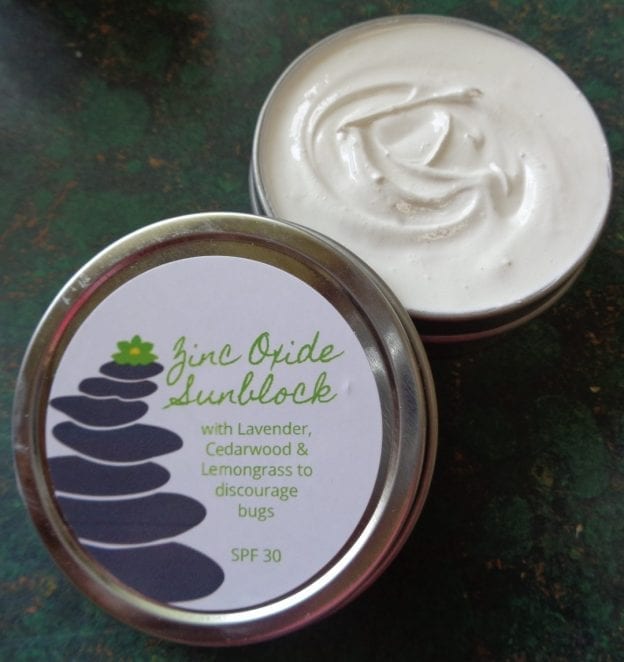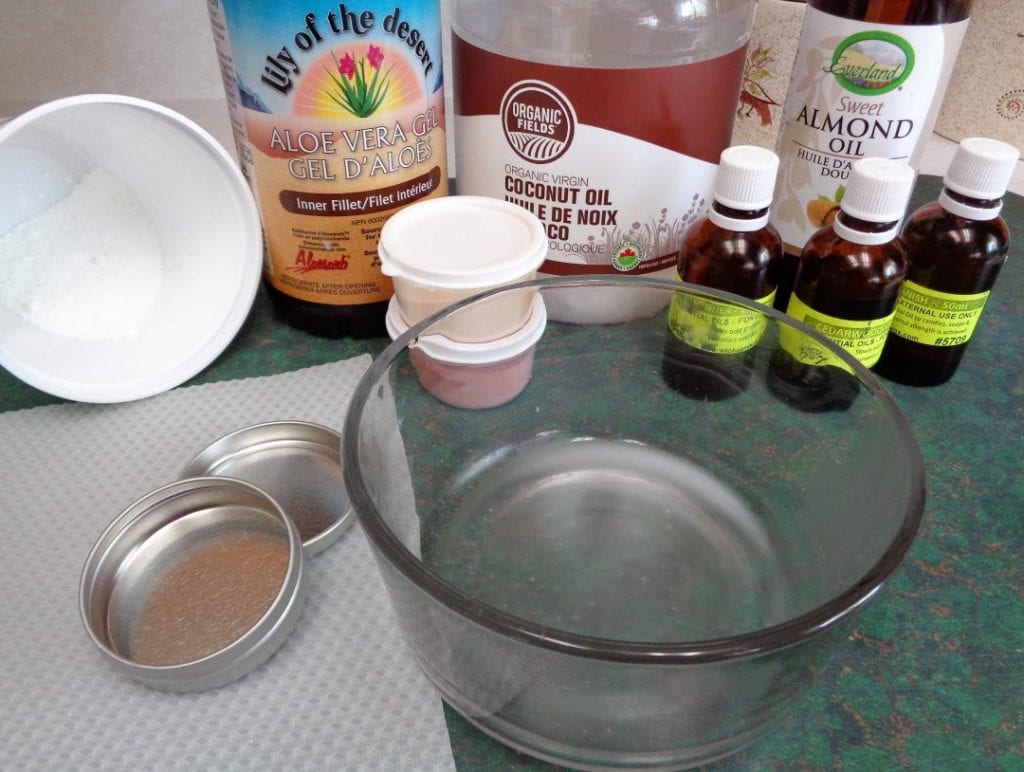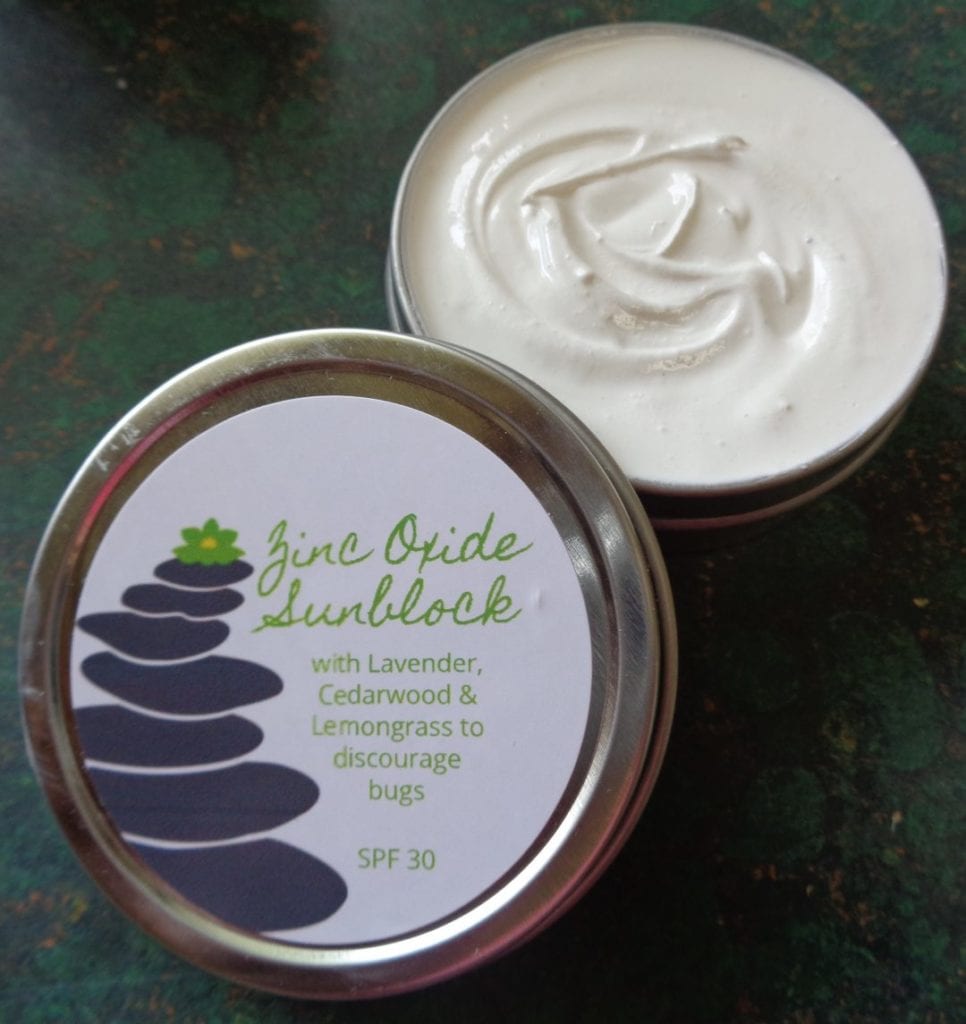We all need sun to be healthy. For one, it helps our bodies manufacture vitamin D. Sunshine also boosts the body’s serotonin level, our happy hormone with its appetite suppressing bonus. It is also connected to preventing or reducing the effects of SAD, diabetes, heart disease, IBD and MS. It boosts your immune system and can help some conditions such as as psoriasis, acne and eczema.
That said, over exposure to UVA and UVB will do long term damage to skin and can result in more serious issues such as skin cancer.
Over the last decade we have seen a move away from chemical sunblockers and towards physical/mineral ones such as zinc oxide and titanium dioxide. Physical sunscreens work better at blocking full spectrum UV rays than chemical sunscreen ingredients and also tend to be rated safer on Environmetal Working Group’s sunscreen database.
EWG released their 2017 annual report suggesting that although there has been improvements over the last ten years, 75% of sunscreens used in North Amrica do not work and half would not be allowed for sale in Europe. They either do no offer enough protection or contain ingredients they consider harmful.
Making your own is not a perfect solution either. Zinc Oxide is the most common DIY sun block in home made recipes and the bottom line is it is very similar to covering yourself with diaper rash cream. The powder, suspended in a cream, reflects, scatters and absorbs the UV rays by actually getting between, the sun and your skin. It is opaque and as it sits on top of the skin will be visable, especially at higher SPFs when there is more Zinc Oxide in the product. Something else to consider when choosing a recipe is that sunblocks have longer, continual contact on skin. This is not like a toothpaste for example that you will use and then rinse away. Sunblocks are usually reapplied and are on bodies for hours at a time.
SPF (Sun Protection Factor) is the calculation of how much protection a specific recipe is giving someone. A common mistake is applying too little sunscreen, which can drastically reduce the effective SPF of the product. About 1 ounce (5-6 teaspoons) of sunblock is recommended to cover an entire body.
Some ingredients in a formula will enhance SPF and others will reduce total SPF. All testing for SPF is done only once a formula is complete and it is done by actually sitting out in the sun and waiting to see what is happening to the skin after twenty minutes of exposure.
Shea butter, Jojoba oil, sunflower oil, coconut oil or sesame oil, eucalyptus and lavender essential oils and vitamin E oil are some examples of ingredients that have very low natural levels of SPF. This does not mean they can be readily used as a sunblocker by themselves. Only that they may give added SPF support to your final homemade product. They will also nourish the skin. Citrus essential oils may increase sensitivity to sunlight and undermine how a sunblock works.
When choosing to make your own sunblock, use a recipe that creates a lotion, not a spray. Getting an even, thick coat with a spray is difficult and breathing the product in is not a good idea, for you or your neighbours.
Different amounts of zinc oxide are needed depending on what SPF you would like your lotion to have. Once you have chosen the SPF a little math is involved. The zinc oxide must be a certain percentage of the weight of your ingredients (before adding the zinc oxide). For this reason, it’s easiest to use a kitchen scale when making your sunscreen.
As an example, if you have 2 ounces of lotion and would like to make SPF 10 sunblock, according to the values below you will need to add .2 ounces of zinc oxide to the lotion.
A 1% increase in zinc oxide content will give an SPF increase of 1.
Specifically in terms of UVB protection, SPF 15 sunscreen blocks 93 percent of UVB radiation, while an SPF 30 sunscreen blocks nearly 97 percent. So there is not a large increase in “bang for your buck” at that level.
For SPF 2-5: Use 5% zinc oxide
For SPF 6-11: Use 10% zinc oxide
For SPF 12-19: Use 15% zinc oxide
For SPF >20: Use 20% zinc oxide
Zinc Oxide is a fine white powder that should be handled carefully when being added to your recipe. Don’t breath it in.
Okay! Let’s get on to some actual making.
I used a recipe I have shared before that contains, coconut and almond oil with aleo vera gel. That post is here. It is a good thing to choose ingredients that will nurture and protect your skin so that a day of full summer weather is balanced with nutrition to keep your skin healthy and happy.
You will need:
3 Tbsp. beeswax, torn into very small pieces
1/4 cup coconut oil
1/4 cup almond oil
1/2 cup aloe vera gel
30 drops each of cedarwood, lavender and lemongrass
1/4 tsp. strawberry powder (optional)
1/4 tsp. papaya powder (optional)
zinc oxide to your requirements
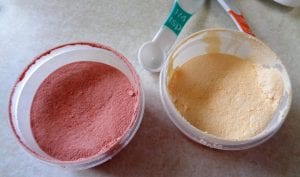 Let’s start with a bit of an explanation for the two optional additions. These are not always easy to find and definitely not a must have but nice to add if you happen to have some around.
Let’s start with a bit of an explanation for the two optional additions. These are not always easy to find and definitely not a must have but nice to add if you happen to have some around.
From Voyager Soaps here is their explanation of the benefit. “Papaya contains the enzyme papain, which has wonderful exfoliating properties – removing dead skin, and specifically damaged skin. It can also help reduce the appearance of freckles or brown spots due to exposure to sunlight, smoothing the skin and creating a healthier appearance.” and for strawberry “Rich in polyphenols and Vitamin C, Strawberry extract provides skin protection, contains soothing properties and is a wonderful toner to reduce the appearance of pores.” The suggested amount to add to any product you are making is .05% and as I mentioned totally optional.
The choice of essential oils may seem a little unusual as well. They were chosen because many bugs DO NOT like the aromas and anything that can help reduce being the buffet for our six legged “friends” is a bonus. You might want to tweak the mix if something else works better in your neck of the woods. Different bugs, different olfactory systems, different likes and dislikes.
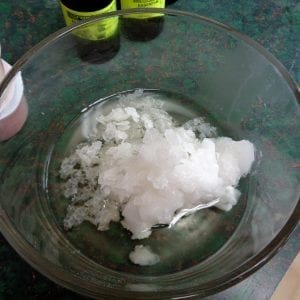 Place the beeswax and coconut oil in a non reactive container and melt over a pot of simmering water or with short bursts in a microwave.
Place the beeswax and coconut oil in a non reactive container and melt over a pot of simmering water or with short bursts in a microwave.
For small projects like this I prefer to use beeswax honeycomb embossed sheets. They are more expensive but very thin so they will melt more quickly meaning your oils will not need to maintain high heat for very long.
Once melted, stir well and mix in the almond oil.
Add in the aloe vera gel. If things are cooling down too quickly you may find the beeswax solidifying. This is not a problem. Heat gently for a few minutes and the mixture will reliquify.
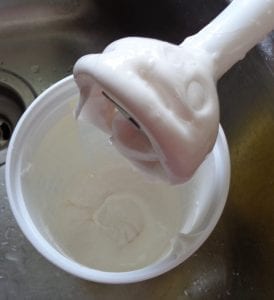 Using an immersion blender, whip the mixture until it is white and creamy. It is possible to stop for a few minutes and allow it to cool a bit in the middle and then return to mixing for more volume.
Using an immersion blender, whip the mixture until it is white and creamy. It is possible to stop for a few minutes and allow it to cool a bit in the middle and then return to mixing for more volume.
I transfered the ingredients to a cleaned, used sour cream container and placed the container in the sink while I whipped just to protect from any spraying.
Add the optional powders and essential oils. Whip again.
Measure out the zinc oxide and add to the lotion.
I wanted part of the mixture to use just as a lotion and the other portion I turned into sunblock for the daughter of a friend of mine, who is very sensitive to sunshine and planning on heading into the Okanagan Valley in a couple of weeks. I measured out 100 grams of lotion and added 30 grams of zinc oxide for an SPF 30 cream. If your brain works in ounces, just use a scale and remember 1% means SPF 1 and 15% gives you about SPF 15 when using zinc oxide.
 As it is being mixed in, the consistency will change and it will thicken, becoming more opaque. The lotion without the zinc oxide is above on the right. The lotion on the left with the zinc oxide is whiter and firmer.
As it is being mixed in, the consistency will change and it will thicken, becoming more opaque. The lotion without the zinc oxide is above on the right. The lotion on the left with the zinc oxide is whiter and firmer.
Mixing well is important to ensure an even spread of the sun blocking ingredients when applying on the skin.
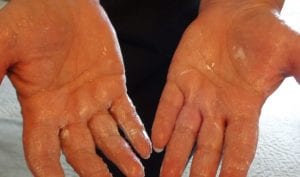 This recipe is also water resistant which will help on days spent around the pool but checking and reapplying as needed are important, Checking will help you find the places that might not have received as much sunblock as needed before it becomes an issue.
This recipe is also water resistant which will help on days spent around the pool but checking and reapplying as needed are important, Checking will help you find the places that might not have received as much sunblock as needed before it becomes an issue.
Don’t hold this over to next season, six months is about maximum storage time and keep in the refrigerator when not being used. Best stored in the cooler, away from hot temperatures when out at the beach all day.
Although this sunblock is good protection, with ingredients considered the current standard, safer than other options on the market, remember to thoroughly shower and remove any remaining cream at the end of the day. Your skin needs an overnight break before starting another day of fun.
Zinc Oxide Sunblock from My Kitchen Wand

